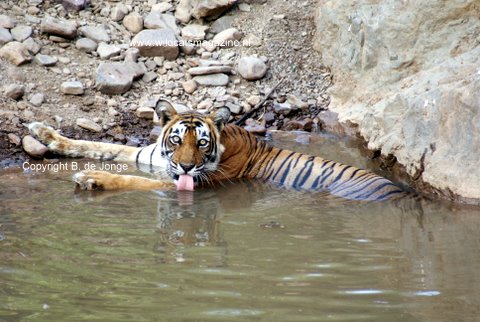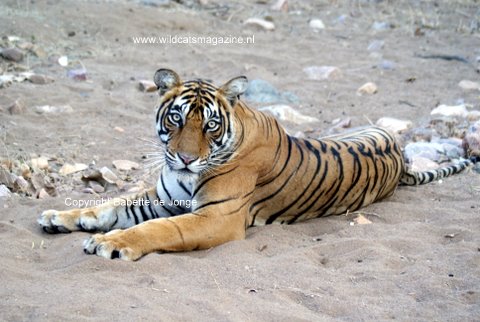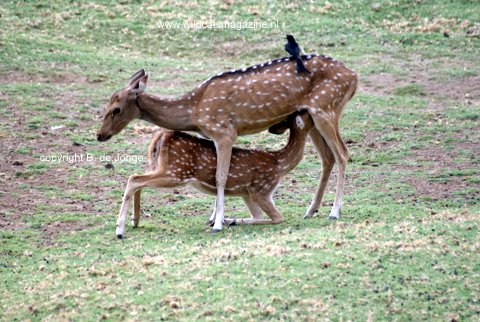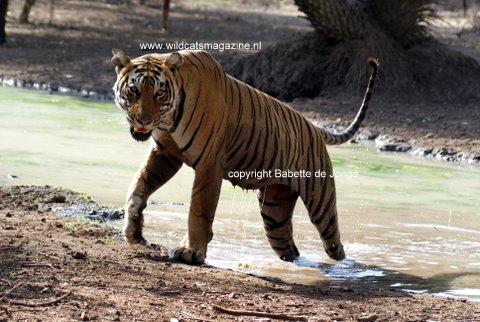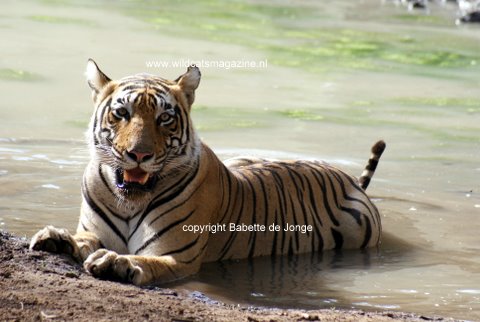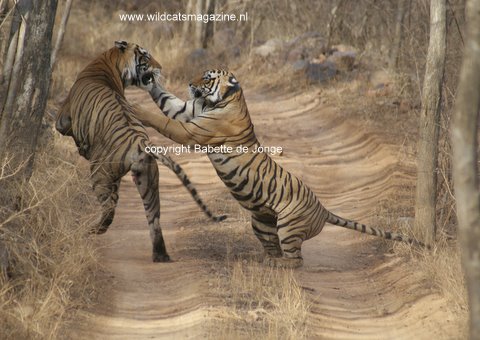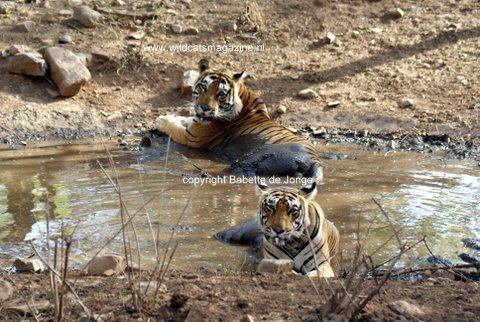Meeting Machli, the grand lady of the jungle
Some places in this world feel like they are just made for you and you want to return there over and over again… one of these places for us is situated in the Sawai Madhopur district of Southeastern Rajasthan, India: Ranthambore National Park.
We feel so much at home driving through one of the so few remaining natural habitats of the tiger, covering an area of approx. 400 km2, and if combined with the area of Sawai Man Singh Sanctuary area, it is around 500 km2. Ranthambore National park was declared a wildlife sanctuary in 1957 and in 1974 it gained the protection of “Project Tiger”. It got its status of a National Park in 1981. Today this park is also affected by ecological pressures and poaching. In the following travel report I will invite you to join us on our search for the Kings and Queens of the Ranthambhore jungle, with temperatures soaring between 37 and 47 degrees centigrade all day, the sun burning on your skin and when even a light t-shirt feels like a warm jacket. Sometimes driving for hours not seeing anything, but in the end realising the Cat Karma was with us again all of the time to give us the best of sightings, even unbelievable for ourselves at times.
After our arrival and first night in Delhi we left early next morning to catch the first train to Sawai Madhopur. Ranthambhore National park is well connected to all major cities in India and from New Delhi it is a train journey of 5,5-6 hours, 362 km. Not only the extreme temperatures but also the hectic and chaotic places, traffic etc. made us realise we were back in India and we got excited just thinking about seeing our favourite tigers in their natural habit again… no fences, no enclosures, no windows… just majestic big cats born to be free… being free… showing themselves only when they want to, hiding when they are tired of all attention. Some people are often referring to tourism as part of destroying nature and of disturbing animals in an unforgivable way. We only agree partly with this. Here in India we are also often very much annoyed about the people lacking the laws of nature and really disturbing the animals by making too much noise, starting the engine every time an animal moves and sometimes chasing it too much. We even witnessed these tourists applauding for tigress Machli making a succesful kill. This is something we will never understand and never can get used to. This is so different to the African countries where they have learned through the years to behave and respect the animals. When you have the opportunity to see these great animals, when they decide to show themselves to you, one should be grateful and enjoy in peace and quiet.
But… once you respect the animals and be relaxed and quiet, it is obvious they don’t mind you being there… not even with lots of people and vehicles around. They have got used to it and most of them seem quite relaxed in the presence of tourists and even take advantage of the vehicles, to stalk some prey animal, to get some shade or sometimes even to hide cubs so that the mother can go hunting. The shy animals just don’t show themselves or stay on a safe distance. We also must not forget that tourism helps saving the endangered animals in a way too. Tourism requires lots of extra jobs and make the local people become more aware of the importance of saving the nature and the animals. Besides, with so many tourists around most of the time, poachers have less opportunities to kill and take the animals unnoticed. The people got to know the animals and know when there’s one missing. So, tourism is important but in a respectful way. We don’t feel guilty at all going and seeing these animals in their natural habitat and we enjoy it while we still can, as sad to say the numbers are still declining and if nothing happens, soon all tigers will disappear from the wild.
Another great thing of returning to the same place is to get reunited with all our friends again. It feels like we haven’t been away for a whole year. Having settled in our air-conditioned hotelroom after the not-so-comfortable train journey, we longed for some great lunch and after that trying to see our first tiger(s) and other wildlife. It felt like yesterday entering the National Park again. We were happy the temperatures weren’t over 40 right away, on the first two days it was “just” 37-40 degrees and also some threatening clouds producing small showers… also when we found our first tigress (T17) and stayed with her for a long time, as she was resting at one place. T17 is a collared female, daughter of Machli, the grand lady of Ranthambhore, sometimes being referred to as Machli II as she is also a very relaxed tigress showing herself to the tourists without any fear. The collar is not meant to search for her with radio equipment but just to collect information, so the fact that she is spotted more frequently than the other tigers, isn’t because of the collar. Shame these collars are always so big and not a nice add for the photographers; trying not to get the collar in the picture is a challenge though and it works. Our great friend and tigerspotter, Nafees, told us that we would start easy this first afternoon. He said that lots of guides and drivers were trying to see T17 or two males in zone 5 (T2 and his son T7) as it pretty sure, though of course not guaranteed, you will see these tigers. The other tigers are a bit harder to spot. But just like Nafees we always love to take a challenge and not to go the easiest way… so the following days we tried to see as many different tigers as possible and of course some unique photographic moments, but this is where the cat karma has to come and help; you need a lot of luck there as the tigers are not really waiting to show you what you are hoping for of course. Though I must admit they were very willing to help us out.
Ranthambore National Park is such a lovely and beautiful place to be; it is a combination of (rough) nature, history and wildlife. There are many ruins of bygone eras and a huge fort, after which the park is named, towers over the park on top of a hill. All remaining structures remind you of bygone times. The many lakes, rivers and waterholes (some of them artificial) are a relief during the extremely hot summer months for the forest inhabitants. They have enough water to drink, and as we all know tigers love to lay down in the water to cool off and there are lots of opportunities for them to do so. The park is divided into 5 different zones. At the entrance of the park it is decided who is going to which zone trying to avoid too many vehicles and tourists at a same sighting. This is really necessary in the high season when you really don’t know what is happening to you with so many tourists wanting to see the tigers. The tigers all have a number so that everbody know which tiger is being referred to. Only a few tigers also have a name where they are famous for, like of course the great Machli (means fish, referring to a fish-shaped pattern on her skin), or T16, but also Star Male, or T28, referring to the “stars” above his eyes. There are supposed to live 30 different tigers in Ranthambhore, though often the same are being seen and some of them are either shy or they live in the zones where no tourists are allowed. This time we managed to see 11 different tigers; two of last year we didn’t see so in total we already saw 13 out of 30 Ranthambhore tigers in short periods of time. Not bad at all!
After the long, hot drives, making you feel sweaty and dirty because of dust sticking to the remains of the suncreme, it felt like heaven to enter the air- conditioned room again and have a refreshing shower. After a great dinner we usually had an (for us) early night to get new energy for a very early start the next morning. Those morning drives were very nice, as it didn’t start as hot as the afternoon drives. However, it is always harder to find the tigers in the morning as they all use to walk long distances during the evening, night and very early morning. Once you spotted a tiger in the morning (and the other vehicles in the other zones) it usually was easier to find these tigers in the afternoon again, as at the hottest time of day they usually were lying down at the same place as it was too hot to keep on walking. Again this is not guaranteed as there are also a few exceptions to the rules who, also during daytime, keep moving or walk a bit further to another place to have a lie down. At the end of a drive tourists always use to share the info on their sightings… always nice to know which tiger has been spotted at a certain zone. It was very strange but it seemed that there were days when all tigers in all zones seemed to have disappeared at the same time. We had it a few times when we had no sighting and then we heard no one had… we joked then that the tigers were having a meeting together on a private place. Like with all cats (also in Africa) you usually see more of them when they are hungry and out for a meal. Once they had a kill they usually hide for days.
On the first day the weather started relatively cool and the sky was partly clouded. Great for us to adjust slowly to the heat, though for the sightings usually not that good. We heard T13 and her 2,5 years old youngsters, T38 and T39, had been spotted the afternoon of the day before, so we drove to zone 1 to try and find them. No luck there. After having searched for quite a while we went back to the entrance. We just missed T17 on her walk alongside the road. We did hurry to a place where there has been spotted another male tiger, but also he had disappeared in the forest, so not much luck the first morningdrive, but still this is what makes it so special and exciting to go and see the cats in their natural habitat… you never know if, when and how you are going to see them. You win some and you lose some… but many more drives to go. First breakfast and then siësta in a nice and cool room 😉
During the afternoon we went to zone 4. Last year we didn’t go to Machli (T16), the oldest and most famous tigress of Ranthambhore, as there was no road to get there (work in progress), but we of course had to try and see the Grand lady of Ranthambhore this time. When we found her there was a group of local people walking close. They had entered the park illegally to steal grass. When they were being warned, in the famous Indian loud way… Machli ran off and went to sit almost out of sight. From another place we observed her from a long distance, so it was hard to see. She was sleeping for a long time, just like her daughter T17 the previous day. After a few hours she went to sit straight and we could see her a bit better. She was yawning and it was so wonderful to hear her roar… .one of our wishes to hear a tiger roar in the jungle. You have to close your eyes and enjoy the sounds..it gives you gooseflesh… it would have, if we weren’t disturbed by some loud people from another vehicle: a small child crying (Machli watched this intently even from a distance) and the adults playing a tape with tiger sounds for Machli… unbelievable really! This went on and on until they finally went off. Machli who was about to start moving a few times was probably disturbed by the noise and did sit down again… finally she turned her back on us (or them). Anyway, it was wonderful to already have seen this famous tigress and we hoped we would see more of her the coming days.
Unfortunately she had disappeared the next morning when we went searching for her again around the same place. They really can make themselves invisible. We did hear her roar again in the distance and also saw pugmarks from that morning and one time we heard an alarmcall. But the lady didn’t want to show herself so we had to respect that. We did see the male tiger T7… he came walking out of of the forest and went to sit down in one of the artificial waterholes, right in front of our gypsy, posing nicely for us. Lots and lots of other tourists there..and too much noise… T7 had his ears flat, but still the water was too good to leave so he just took the noise for granted. Good to see him again, safe and sound, we did see him last year too, but you never know what happens in 1 year.
The temperature was increasing the later it got… heading for the 40. When we were searching for T39 (daughter of T13) we suddenly saw another tigress who had been lying in a waterhole, but as she was a bit shy she went away quickly when she heard us coming. In silence we waited a while in the hope she would return to the waterhole. We tried to make the people in the other vehicles present understand we had to be as quiet as possible… and when she actually came back we had to drive slowly to a good place to see her. Any abrupt movements would for sure scare her off again. It worked and she went to sit in the water for a while. It is a bit unsure yet who she is. At first we were told it was T25… but later we heard it probably is T22. Anyway, a beautiful tigress and lovely to see her.
On our way back we finally found T39, who was sleeping at quite an open place. She was very relaxed in presence of the vehicles and the times we saw her she was a real good poser. One morning on our search for tigers we drove past a natural waterhole and all of our eyes were caught by some movement on the right of us… a big croc went into the water. We witnessed this for a while and after this, we looked, our faces forward again, to drive on… realising suddenly that a tigress had been watching us all of the time… .. T39 sat there waiting and probably confused that we didn’t look at her… she of course is not used to that. We really had fun because of this hilarious situation.
We spent quite a long time with her this morning, while she was grooming, relaxing, attempting to chase a sambar deer, snarling to crocs who were lying in “her” waterhole when she wanted to drink there and cool off and eventually on her morning walk ending up in another (artificial; so without crocs) waterhole, when we and the other tourists had to leave her. Needless to say that this beautiful young tigress grew to be one of our favourite tigresses of Ranthambhore. The other one is good old Machli, who we ended up seeing several times and she really treated us with the best sightings.
It is funny that tigers (and all cats), like Machli, sometimes show themselves on a short distance from humans and gypsies, but once they want to get out of sight for a while, you really cannot find them or if you are lucky you can see them from a great distance. A lot of days when we or other tourists were looking to see her, she was either very far away or she couldn’t be found at all. “The star is leading her private life now” our guide said. And it is so good they have one. Soon they will have a long time “in private” when the park closes from july until october because of the monssoon. But fortunately we were so lucky to have seen the grand lady from very close too, when she was resting (and posing for the Paparazzi) on the rocks, or going to have a cool off in the wonderful, natural waterhole like we hoped she would. She went resting a while in front of our vehicles, trying to use a bit of the shade and she did treat us with some roars again. Such a shame that the drivers didn’t let her and started the engines again, chasing her off… following her again. We were so fed-up with this and told Nafees to leave her in peace, like everybody should, and we left. I mean, she gave us so much, why push it any further and keep on disturbing the animal.
During one very hot afternoon (at least 45 degrees) we really had a hard time. In Machli’s territory there was hardly any shade. She was resting a long way from us down-hill near a “pool” and we had to wait for her up in the sun, after driving for a long time already in the soaring heat. We honestly didn’t know if it was worth the waiting as it was so bloody hot and the clever cat was already having water close to her, so why would she bother coming all the way up, to pass lots of vehicles with lots of tourists, just to go to another waterhole? “Why would she bother being active at all? “, we asked ourselves, probably referring to ourselves and the difficulties we had this afternoon dealing with the heat and no-shadow problem. But… a good time to show how unpredictable the wild animals are, even the wild cats, who are always referred to as being lazy. Machli did come up, passed near the vehicles and suddenly went down behind one gypsy, suddenly looking very alert and adapting a pose of a cat that has a kill in her mind. Not far from the place we saw a group of Sambar deer, who didn’t seem to have noticed the tiger sneaking up to them behind the vehicles. They were probably paying more attention to the tumult the vehicles were causing and Machli took advantage of this. She soon started running and jumped onto one of the big sambar deer and knocked it down. We were a bit worried before if Machli would still be able to make a kill, as she is getting quite old and with only one canine teeth left, but in one instant moment all our worries had disappeared. Wow, what a killer cat. The loud audience was applauding but we decided not to pay attention to this and use the extra adrenaline to make great stills and footage of this unbelievable rare moment. To see a cat kill right before your eyes is as unique as it can be, but to see a tiger making a kill like this, just is once in a lifetime.
After the sambar deer released his final breath, and the other deers stopped calling for him, Machli tried to drag the kill to a more private place, but this didn’t work. The male sambar was about twice her size and then again with only one canine teeth left it was just impossible. So, against the nature of a tiger, Machli started eating with us still present. After a while she got up, went to the waterhole to have a drink and lay down… unfortunately it was for us the time to go and rush back, as the park was going to close for the night. We expected to find Machli with her kill again the next morning, just like a lot of other tourists, but we found the kill not touched again after we left the evening before, only one vulture trying to eat a bit. Machli was resting not very far from the kill, but the days after she had disappeared. And no one ever touched the kill again, not Machli, not another tiger in the same territory and also not a leopard or another predator who got the smell of it..and believe me it did smell, esp. after a few days. So it gave us fantastic photographic moments but the kill really was a waste…
The next afternoon Machli was found again by other tourists down-hill near the waterhole where she was watching a croc making a kill, also a sambar, and the lady waited for the right moment to steal this kill and this one she did eat… but this was at a more private place and this is what tigers prefer: no audience at dinnertime! Oh, what a cat… .
Last year we also had great tigersightings but they didn’t measure up to this year’s. But we did have very exclusive sightings of caracals, mother with two youngsters, last year and also saw leopards, sloth bear and a jungle cat running over the road. This year we saw a leopard on great distance, a very quick sighting while we were on our way out from the park, surrounded by lots of other cars and tourists, and we saw a jungle cat running off when he spotted us. Of course we also enjoyed the sight of all other animals like the langur monkeys, deer, peacocks, various birds, crocs, jackal etc.
But… the tiger sightings were the best for us this time… it became really unbelievable as everything we hoped and dreamed to see, but certainly didn’t expect to happen in one trip and it probably will never happen again the next times, we did see. We had tigers in certain waterholes in mind for photos, a tiger kill, tigers mating… Even Nafees and the drivers were surprised about the luck we had all together. Cat karma!
Usually male tigers are more difficult to spot as they are more elusive, with a few exceptions to the rules. In zone 5 you can regularly see the male tigers T7 and his old dad T2. They both love to stay near the water and cool off in the nearby waterholes during these hot days. Father and son do even share a place in the water every now and then, like they sometimes do share a kill. T2 is the oldest male tiger of Ranthambhore, dad of most of the younger tigers, and he certainly has a history having been the dominant male for a long time. This you could see on his worn-out face with lots of scratches. One of the stories T2 is famous about is for attacking a man with a donkey who were walking in his territory. Now if you look at the true story it has to be said that it wasn’t a wise action of this man, who tried to protect his donkey against the big male tiger when he attacked. If he wouldn’t have done this and walked away instead nothing would have happened to him. It was the donkey T2 was after, an easy meal walking in his territory, who can blame him? So sad that this went out of hand… humans don’t seem to understand nature anymore these days.
Over a year ago T2 fought with tigress T4, who was protecting her cubs T40 and T41, and she died due to her injuries. The cubs could get away and had to be fed as they couldn’t hunt for themselves properly yet. We did see T40, a beautiful looking male now, when he got out of the forest to have a cool off near the water. He intentionally wanted to go in the water but the crocs stopped him from doing so. He sat down on the waterside. Lots of deer and peacocks did go and have a drink despite the presence of the tiger and crocs. Nice to hang around a bit longer to watch all lovely animals.
T7 is the son of T2 and T5, a female we saw last year and also on this trip we were so fortunate to meet her again. He is a beautiful male tiger. One time he really made us laugh. He was sitting in the waterhole and after a while he decided we had seen enough of him, so he strolled through the water and went to sit on the other side of the water, with a big rock in the way to block our view. But when he arrived there, he peeped over the rock very sneaky one time, to see if we were still there. A very funny sight of course. Also it is funny when tigers are in the water, like T7 and T2, they like to keep one paw dry, so for a long time they keep it in the air, even though they are under water with the rest of their bodies. Eventually they give up and let the paw into the water too. After one afternoon drive when we were hurrying to get out of the park, we spotted T5 in the water from a distance so we drove slowly nearby and tried to avoid making any other noise, as she would for sure jump up and leave. T5 is relaxed when you enter her with caution, but she is a bit shy so if there’s too much movement and noise you can just see her leave, like we did the morning after, when another car in front of us apparantly wasn’t quiet enough. But this afternoon she allowed us to come fairly close and have her pictures taken. She is such a beauty. Last year she was the first tigress we saw during our first stay in Ranthambhore and we saw her another time too. When she was gone we watched the photo of her getting out of the water again, and Nafees told us she is pregnant. They had the feeling for a while because of how she behaved lately but now you could also see it to her nipples. Well let’s hope for some new cubs in Ranthambhore as it has been a while, and this is still on our wishing list.
One of the most popular male tigers of today is T28, also called Star Male, because of the star-like stripes above his eyes. A wonderful big male. We saw him on two mornings. Male tigers are often walking through their territory, scent marking the trees etc. to let other males know it’s their place. When you are lucky you sometimes find them doing so. One morning he wasn’t keen on tourists watching him so he disappeared in the forest fairly quickly but another morning when we spotted him drinking water and having his morning bath he was very relaxed and we could take some nice photos. The light was brilliant and so was the reflexion in the water. After his bath he disappeared again, but lucky we were just driving at another place later on when he was just crossing the road again. Sadly some other nice people we met, and didn’t see a tiger yet, just missed him. That’s how you can see it is just a matter of luck and being at the right place at the right time. If you are there one second too soon or too late, you’d just miss the moment. Of course it happened to us a few times too… so we count ourselves lucky the moments we are in time.
One morning we saw a big male in the territory of Star Male, walking in the area near the entrance where you have to pass to go to zone 4 and 5. At first we assumed it was him as it was from quite a distance but when we watched our pics we saw right away that the “stars” were missing and that this was in fact another male. He looked so much like T12 but that male used to wear a collar, so either he lost it or it was a different male after all. Hard to say so we had to get ourselves informed by some parkmanagement officers first. It was so great as this male tiger was roaring… it was already a big treat to hear Machli roaring a few times, but to hear this big male..wow, it hit you right into your heart. No disturbing noise this time, so we just had to close our eyes,listen and enjoy… a peacock was answering him… perfect jungle sounds. The same afternoon we found the same tiger, and now it was confirmed that it actually was T12 who had lost his collar, resting in the remains of a palace. He was really hot and did breath very fast with his mouth wide open. We took some shots and left, so that the “poor” male could enjoy his rest. We already had siësta ourselves and you really need it with these kind of temperatures.
One day before we had to leave to Delhi again for our flight back to Amsterdam, we sat down with Nafees and told him for fun really that the next morning drive, our final one of this trip, had to be one with the most smashing sighting of all. We really laughed about it as let’s be honest what can possibly be a better sighting then we already had the past few days? A kill by Machli, isn’t this what every wildlife photographer and tiger”freak” is dreaming about? And then all the tigers up close and personal posing so nicely for us. We felt so fortunate and nothing could spoil our trip but we thought not much could be an add to it either.
So the next morning we sat down relaxed and decided to enjoy our last drive and chances for tigers to the fullest. When we had just entered the park we got excited right away as a male tiger was walking in front of us on the road. We didn’t have time to identify the tiger yet as very quickly he jumped from the road down hill and out of sight. We thought we caused this but when we drove a bit further we saw another tiger… ..tigress T17 sitting on the road, very alert, watching where her possible mating partner had gone too. Unbelievable, not one but two tigers at the same time and a female and a male, just like we hoped to see. This was the start of 2 hours full excitement and my wildlife tigershot of the year… at least of this trip. How fortunate can one be??
T17 was at first more interested in, who happened to be, T12 and it was funny to see her following and “chasing” him and not the other way round. We managed to follow the two as well as possible. Sometimes they were in sight and sometimes out of sight. Some moments we could only hear them… one time it was close to a mating session, though behind trees… yes, it is not always easy for a photographer to take the perfect shots. Then after a while they were finally walking on the road together for a brief moment… and some super interaction followed… and I was able to take one of my favourite wildlife shots in my “career”. To photograph one tiger nicely in the wild can be very difficult though not impossible, to have the same opportunity with two tigers, not related ones and being male and female, is a chance of a lifetime. They also went to sit in the water together. Firstly T17 and T12 looked carefully first if it was safe and then went to sit down too. A cool off was really welcome after the long distance they walked. After a while T17 went out and went to T12 and invited him to mate… We were impatient to get mating shots this close, but unfortunately T12 didn’t get the message… or pretended not to be interested. He probably liked a more private place to mate as where T17 didn’t care; she really had set her mind on him no matter what.
While they were still walking on together we stopped for a while and looked back on this exceptional sighting before leaving the park for the last time this year. Nothing could measure up to this sighting and all sightings we had the days before, so we decided to call it the quits sooner and the other tourists present this morning did the same. Some of them wanted to say “hi” as they recognised me from the article in the Indian paper not long ago, but also from my website and Facebook. They even wanted to have their photos taken with us. Nice to end our unforgettable stay with. Now we had to return to our hotel and make ourselves ready for the train journey back to Delhi and the flight home during the following night.
We like to express our sincere thanks to all people at Ranthambhore Regency, to the kind people at Ranthambhore National Park esp. to Kailash, our fantastic drivers and our biggest thank you goes again to our great friend, the one and only Nafees. Thank you all for making our stay so memorable again and we see you all soon again!
For more photos refer to the Magnificient cats Photogallery.
Copyright text and photos by: Babette de Jonge
www.wildcatsmagazine.nl









